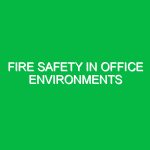Introduction to Falls in the Office
Falls in the office are a significant concern within the realm of Health, Safety, and Environment (HSE). This issue encompasses a range of incidents, from slipping on wet floors to tripping over loose cables or even falling from heights when using ladders. The relevance of understanding and mitigating these risks cannot be overstated, as falls are among the leading causes of workplace injuries. According to the Occupational Safety and Health Administration (OSHA), slips, trips, and falls account for a considerable percentage of all workplace injuries, impacting not only employee health but also organizational productivity and morale.
This article aims to explore the various aspects of falls in the office, including potential hazards, safety precautions, and relevant regulations. By the end, you’ll have a comprehensive understanding of how to create a safer workplace environment.
Identifying Hazards and Risks Associated with Falls in the Office
To effectively prevent falls, it is crucial to first identify the potential hazards in an office environment. Here are some common risks that may lead to falls:
1. Slippery Floors
Wet or slippery floors are a frequent cause of falls. Whether due to spills, cleaning activities, or even rainwater tracked inside, these surfaces can pose serious risks. For example, a personal anecdote shared by a colleague involved a slip on a wet floor while rushing to a meeting, resulting in a sprained ankle. Such incidents highlight the need for immediate action to mitigate these risks.
2. Cluttered Walkways
Clutter is another hazard that can lead to falls. Items such as boxes, cables, or even discarded materials can obstruct pathways. One case study from a corporate office revealed that employees often left their personal belongings in common areas, leading to numerous trip incidents. Implementing a clean desk policy can help reduce clutter and enhance safety.
3. Poor Lighting
Inadequate lighting can make it difficult to see potential hazards. A dimly lit office space increases the likelihood of misstepping or not noticing obstacles. For instance, an employee recounted nearly tripping over a raised floor panel in a poorly lit corridor. Ensuring that all areas of the office are well-lit is essential for reducing fall risks.
4. Improper Use of Ladders
Using ladders or step stools improperly can lead to falls from height. Employees sometimes attempt to reach high shelves without adequate support, risking serious injury. A training session on proper ladder usage can significantly reduce these incidents.
5. Uneven Surfaces
Uneven flooring, such as changes in elevation or worn carpets, can create tripping hazards. Regular maintenance and inspections can help identify and rectify these issues before they lead to accidents.
Safety Precautions and Best Practices
Now that we’ve identified the hazards associated with falls in the office, let’s delve into effective safety precautions and best practices to mitigate these risks.
1. Maintain Clean and Dry Floors
To avoid slips, it’s essential to keep floors clean and dry. Implementing a routine cleaning schedule can ensure that spills are promptly addressed. Placing mats at entrances can also help trap moisture and reduce the risk of slips.
2. Encourage a Clutter-Free Environment
Creating a culture that prioritizes cleanliness and organization can significantly reduce trip hazards. Encourage employees to keep walkways clear and to store personal items in designated areas. Regular reminders and training can reinforce this practice.
3. Improve Lighting
Ensure that all areas of the office are adequately lit. This includes not only workspaces but also hallways, stairwells, and break rooms. Installing motion-sensor lights in less frequently used areas can be an effective solution.
4. Provide Proper Training
Offering training sessions on fall prevention is crucial. Employees should be educated on the proper use of ladders and the importance of reporting hazards. Providing visual aids or manuals can enhance understanding.
5. Conduct Regular Inspections
Establish a routine for inspecting office spaces for potential hazards. This includes checking for uneven surfaces, loose cables, and overall cleanliness. Encourage employees to report any concerns immediately.
6. Use Anti-Slip Mats
In areas prone to moisture, such as break rooms or near entrances, anti-slip mats can provide an extra layer of protection. These mats can significantly reduce the likelihood of slips and falls.
Regulations and Standards Governing Falls in the Office
Understanding the regulatory framework surrounding falls in the office is vital for compliance and safety. Organizations must adhere to various standards set by OSHA and other regulatory bodies.
1. OSHA Regulations
OSHA provides guidelines to ensure workplace safety, including specific regulations related to slips, trips, and falls. Employers are required to maintain a safe working environment and to identify and mitigate potential hazards. Failure to comply can result in fines and penalties.
2. ANSI Standards
The American National Standards Institute (ANSI) also sets standards for workplace safety. These include recommendations for the design and maintenance of office spaces to minimize risks associated with falls.
3. Local Regulations
In addition to federal guidelines, many states and local jurisdictions have their own regulations regarding workplace safety. Organizations must stay informed about these regulations to ensure compliance and enhance safety measures.
Conclusion: Creating a Safer Office Environment
Falls in the office are a serious concern that requires proactive measures from employers and employees alike. By identifying potential hazards, implementing safety precautions, and adhering to relevant regulations, organizations can create a safer work environment.
Whether through regular training sessions, maintaining clean and dry floors, or conducting inspections, every effort counts. Remember, a safe workplace is not just about compliance; it’s about valuing the well-being of every employee. By fostering a culture of safety, organizations can reduce the incidence of falls, enhance productivity, and promote a positive work atmosphere.
In the end, it’s not just about preventing falls; it’s about ensuring everyone goes home safe and sound each day.


